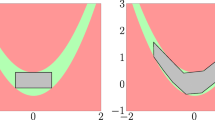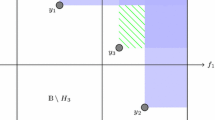Abstract
In engineering, it is often desirable to find a subset of the set of feasible designs, a solution space, rather than a single solution. A feasible design is defined as a design which does not violate any constraints and has a performance value below a desired threshold. Performance measure, threshold value and constraints depend on the specific problem. For evaluation of a design with respect to feasibility, a model is required which maps the design parameters from the input space onto the performance measures in the output space. In state-of-the-art methodology, iterative sampling is used to generate an estimate of the frontier between feasible and infeasible regions in the input space. By evaluating each sample point with respect to feasibility, areas which contain a large fraction of feasible designs are identified and subsequently resampled. The largest hypercube containing only feasible designs is sought, because this results in independent intervals for each design parameter. Estimating this hypercube with sufficient precision may require a large number of model evaluations, depending on the dimensionality of the input space. In this paper, a novel approach is proposed for modeling the inequality constraints and an objective function in a way for which a linear formulation can be used, independently of the dimensionality of the problem. Thereby the exact solution for the largest feasible hypercube can be calculated at much lower cost than with stochastic sampling as described above, as the problem is reduced to solving a linear system of equations. The method is applied to structural design with respect to the US-NCAP frontal impact. The obtained solution is compared to numerical solutions of an identical system, which are computed using reduced order models and stochastic methods. By this example, the high potential of the new direct method for solution space computation is shown.








Similar content being viewed by others
References
Carvalho M, Ambrosio J, Eberhard P (2011) Identification of validated multibody vehicle models for crash analysis using a hybrid optimization procedure. Struct Multidiscip Optim 44(1):85–97. doi:10.1007/s00158-010-0590-y
Doyle J, Csete ME (2011) Architecture, constraints and behavior. Proc Natl Acad Sci USA 108
Duddeck F (2008) Multidisciplinary optimization of car bodies. Struct Multidiscip Optim 35(4):375–389
Duddeck F, Wehrle EJ (2015) Recent advances on surrogate modeling for robustness assessment of structures with respect to crashworthiness requirements. In: 10th Europ. LS-DYNA Conf., Würzburg, Germany
Fender J. (2013) Solution Spaces for Vehicle Crash Design. PhD thesis, Department of Civil, Geo, and Environmental Engineering, Technische Universität München
Fender J, Duddeck F, Zimmermann M (2014) On the calibration of simplified vehicle crash models. Struct Multidiscip Optim 49(3):455–469
Fender J, Graff L, Harbrecht H, Zimmermann M (2014) Identifying key parameters for design improvement in high-dimensional systems with uncertainty. J Mech Des
Huang M (2002) Vehicle Crash Mechanics. CRC Press LLC
Kim CH, Mijar AR, Arora JS (2001) Development of simplified models for design and optimization of automotive structures for crashworthiness. Struct Multidiscip Optim 4(22):307–321. doi:10.1007/PL00013285
Ladeveze P (2002) On a theory of the lack of knowledge in structural computation. Technical Note SY/XS 136 127, EADS Launch Vehicles, in French
Ladeveze P, Puel G, Romeuf T (2006) On a strategy for the reduction of the lack of knowledge (lok) in model validation. Reliab Eng Syst Saf
Lehar M, Zimmermann M (2012) An inexpensive estimate of failure probability for high-dimensional systems with uncertainty. Struct Saf 3637:3238. doi:10.1016/j.strusafe.2011.10.001
Nocedal J, Wright SJ (1999) Numerical Optimization. Springer-Verlag
Zimmermann M, Hoessle JEV (2013) Computing solution spaces for robust design. Int J Numer Methods Eng 94(3):290–307
Author information
Authors and Affiliations
Corresponding author
Rights and permissions
About this article
Cite this article
Fender, J., Duddeck, F. & Zimmermann, M. Direct computation of solution spaces. Struct Multidisc Optim 55, 1787–1796 (2017). https://doi.org/10.1007/s00158-016-1615-y
Received:
Revised:
Accepted:
Published:
Issue Date:
DOI: https://doi.org/10.1007/s00158-016-1615-y




